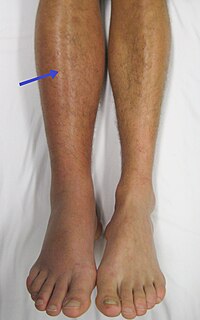
Photo from wikipedia
Dear Editor, Fibrinogen is a protein produced following inflammation, and hyperfibrinogenemia is known as a poor prognostic factor in various tumors. In recent years, it has also been reported that… Click to show full abstract
Dear Editor, Fibrinogen is a protein produced following inflammation, and hyperfibrinogenemia is known as a poor prognostic factor in various tumors. In recent years, it has also been reported that hyperfibrinogenemia is a poor prognostic factor in diffuse large B-cell lymphoma [1]. However, whether hyperfibrinogenemia is a prognostic factor in patients with lower-risk myelodysplastic syndromes (MDS) remains unclear. We conducted the present study to assess the clinical significance of plasma fibrinogen levels in lower-risk MDS patients. We retrospectively reviewed 87 patients who had been diagnosed with MDS and classified as having a low or int-1 IPSS score in our hospital between 2007 and 2017. A receiver operator characteristic (ROC) curve was used to generate a cutoff value for fibrinogen. The Kaplan-Meier method and univariate and multivariate analysis by Cox proportional hazards model were performed to assess the prognostic influence of the factors including the age (>60 years), number of blasts in the bone marrow (> 4%), performance status (PS) (≥ 2), albumin levels (< 3.5 g/dl), hemoglobin value(< 10 g/dl), lactate dehydrogenase (LDH) (> 211 IU/l), karyotype risks (normal karyotype, del(5q), and others), ferritin (> 277 ng/ml), and fibrinogen, on the 6-year overall survival (OS). We also performed the Pearson correlation test to analyze the relevance between fibrinogen and ferritin levels. Table 1 shows the background characteristics of each group stratified by fibrinogen levels. There were no significant differences in fibrinogen levels among IPSS-R groups. Fisher’s exact test was used to compare binary variables, while the Mann-Whitney U test was used to compare continuous data between groups. The optimal cutoff value of fibrinogen for the 6-year OS was set at 323 mg/dl, and 47 patients were assigned to the highfibrinogen group, while 40 were assigned to the low-fibrinogen group. As shown in Fig. 1, the Kaplan-Meier method revealed that patients with hyperfibrinogenemia showed an inferior 6-year OS compared with those without hyperfibrinogenemia (6-year OS: 24.9% vs. 53.5%, P = 0.004). Univariate and multivariate analyses shown in Table 2 identified karyotype risks, anemia, and hyperfibrinogenemia as prognostic factors for the 6-year OS. There was no correlation between fibrinogen and ferritin (correlation coefficient:−0.059, P = 0.611). Furthermore, the same analysis was performed between the highand lowferritin groups, but no significant difference in the survival rate was noted (6-year OS: 42.6% vs. 35.2%, P = 0.719). The cutoff value was also set based on the ROC curve at 277 ng/ml. Our analysis suggests that a high plasma fibrinogen level at the time of the diagnosis may be a factor that affects the prognosis of patients with lower-risk MDS. Several potential mechanisms accounting for the association between hyperfibrinogenemia and poor outcome have been explored. It was reported that fibrinogen could induce the synthesis of interleukin-6 (IL-6) that is closely associated with tumor progression [2, 3]. Moreover, it has also been reported that increased plasma levels of IL-6 were associated with inferior leukemia-free survival in patients with MDS [4]. Therefore, high plasma fibrinogen induced by chronic inflammation may facilitate disease progression by inducing IL-6 synthesis. It has also been demonstrated that fibrinogen was capable of binding to several growth factors and vascular endothelial cell growth factors and functions as a reservoir for these factors [5–8]. These growth factors play important roles in promoting cell proliferation, metastasis, and angiogenesis and inhibiting apoptosis of cancer cells. Taken together, these present and previous findings suggest that hyperfibrinogenemia may cause a poor prognosis in case of MDS due to disease progression via producing several inflammatory cytokines or growth factors. * Tomonori Nakazato [email protected]
Journal Title: Annals of Hematology
Year Published: 2019
Link to full text (if available)
Share on Social Media: Sign Up to like & get
recommendations!